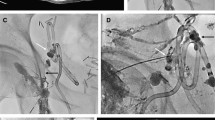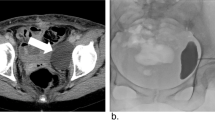Abstract
This study was performed to compare clinical outcomes of lymphatic n-butyl cyanoacrylate (NBCA) embolization and ethanol sclerotherapy in patients with symptomatic postoperative pelvic lymphoceles. This prospective, open-label, randomized, and controlled trial took place at two medical centers in Korea. Patients ≥ 18 years old with symptomatic postoperative pelvic lymphoceles were randomly assigned (1:1) to one of two study arms: embolization or sclerotherapy. A target of 44 patients was set for each group to assess clinical outcomes. The trial began in August 2018 but ended as a pilot study in February 2020. Problematic patient enrollment precluded full population recruitment, only 11 patients (embolization, 5; sclerotherapy, 6) eventually participating. Clinical success and drainage tube removal rates were 100% in both arms. To achieve clinical success, significantly more procedures were needed in the sclerotherapy group than in the embolization group (4.5 ± 1.23 vs 2.0 ± 1.00; p < 0.001). The time to achieve daily drainage reduction thresholds (< 20 mL or < 20% of initial daily drainage) was also less in the sclerotherapy (vs embolization) group but fell short of statistical significance (4.8 ± 2.63 days vs 7.0 ± 3.67 days; p = 0.267). No significant adverse events or recurring symptomatic lymphoceles were evident at 3-month follow-up visits. Both NBCA embolization and ethanol sclerotherapy might be safe and effective in treating symptomatic postoperative pelvic lymphoceles, showing no significant difference in clinical outcomes. In a future randomized prospective study, it is essential to establish better inclusion criteria to selectively include intractable lymphoceles to find out the difference in the outcome between the two treatments.
Trial registration: The study is registered as KCT0003078 at the Clinical Research Information Service (http://cris.nih.go.kr). Registered April 2, 2018.




Similar content being viewed by others
Data Availability
The datasets used and/or analyzed during the current study are available from the corresponding author on reasonable request.
Code Availability
Not applicable.
Abbreviations
- PCD :
-
Percutaneous catheter drainage
- NBCA :
-
N-Butyl Cyanoacrylate
References
Kim HY, Kim JW, Kim SH, Kim YT, Kim JH. An Analysis of the Risk Factors and Management of Lymphocele after Pelvic Lymphadenectomy in Patients with Gynecologic Malignancies. Cancer Res Treat. 2004;36(6):377. https://doi.org/10.4143/crt.2004.36.6.377.
Angelo N, Rossana A, Carlo I, Vincenzo F, Paolo P. Predictors of Symptomatic Lymphocele After Lymph Node Excision and Radical Prostatectomy. Urology. 2010;75(3):630–5. https://doi.org/10.1016/j.urology.2009.03.011.
Keskin MS, Argun ÖB, Öbek C, Tufek I, Tuna MB, Mourmouris P, et al. The incidence and sequela of lymphocele formation after robot-assisted extended pelvic lymph node dissection. Bju Int. 2016;118(1):127–31. https://doi.org/10.1111/bju.13425.
Igor T, Christian T. Risk factors, complications and management of lymphocele formation after radical prostatectomy: A mini-review. Int J Urology Official J Jpn Urological Assoc. 2019;26(7):711–6. https://doi.org/10.1111/iju.13964.
Kim JK, Jeong YY, Kim YH, Kim YC, Kang HK, Choi HS. Postoperative pelvic lymphocele: treatment with simple percutaneous catheter drainage. Radiology. 1999;212(2):390–4. https://doi.org/10.1148/radiology.212.2.r99au12390.
Akhan O, Karcaaltincaba M, Ozmen MN, Akinci D, Karcaaltincaba D, Ayhan A. Percutaneous transcatheter ethanol sclerotherapy and catheter drainage of postoperative pelvic lymphoceles. Cardiovasc Intervent Radiol. 2007;30(2):237–40. https://doi.org/10.1007/s00270-006-0180-y.
Mahrer A, Ramchandani P, Trerotola SO, Shlansky-Goldberg RD, Itkin M. Sclerotherapy in the management of postoperative lymphocele. J Vasc Interv Radiol. 2010;21(7):1050–3. https://doi.org/10.1016/j.jvir.2010.03.014.
Kos S, Haueisen H, Lachmund U, Roeren T. Lymphangiography: forgotten tool or rising star in the diagnosis and therapy of postoperative lymphatic vessel leakage. Cardiovasc Intervent Radiol. 2007;30(5):968–73. https://doi.org/10.1007/s00270-007-9026-5.
Nadolski GJ, Itkin M. Feasibility of ultrasound-guided intranodal lymphangiogram for thoracic duct embolization. J Vasc Interv Radiol. 2012;23(5):613–6. https://doi.org/10.1016/j.jvir.2012.01.078.
Hur S, Shin JH, Lee IJ, Min SK, Min SI, Ahn S, et al. Early Experience in the Management of Postoperative Lymphatic Leakage Using Lipiodol Lymphangiography and Adjunctive Glue Embolization. J Vasc Interv Radiol. 2016;27(8):1177-86 e1. https://doi.org/10.1016/j.jvir.2016.05.011.
Baek Y, Won JH, Kong TW, Paek J, Chang SJ, Ryu HS, et al. Lymphatic Leak Occurring After Surgical Lymph Node Dissection: A Preliminary Study Assessing the Feasibility and Outcome of Lymphatic Embolization. Cardiovasc Intervent Radiol. 2016;39(12):1728–35. https://doi.org/10.1007/s00270-016-1435-x.
Chu HH, Shin JH, Kim JW, Noh SY, Yang WJ, Park S. Lymphangiography and Lymphatic Embolization for the Management of Pelvic Lymphocele After Radical Prostatectomy in Prostatic Cancer. Cardiovasc Intervent Radiol. 2019;42(6):873–9. https://doi.org/10.1007/s00270-019-02209-6.
Kim SW, Hur S, Kim SY, Cho JY, Kwak C, Kim HS, et al. The Efficacy of Lymph Node Embolization Using N-Butyl Cyanoacrylate Compared to Ethanol Sclerotherapy in the Management of Symptomatic Lymphorrhea after Pelvic Surgery. J Vasc Interv Radiol. 2019;30(2):195-202 e1. https://doi.org/10.1016/j.jvir.2018.09.038.
Frost JA, Webster KE, Bryant A, Morrison J. Lymphadenectomy for the management of endometrial cancer. Cochrane Database Syst Rev. 2017;10:CD007585. https://doi.org/10.1002/14651858.CD007585.pub4.
Lin H, Ding Z, Kota VG, Zhang X, Zhou J. Sentinel lymph node mapping in endometrial cancer: a systematic review and meta-analysis. Oncotarget. 2017;8(28):46601–10. https://doi.org/10.18632/oncotarget.16662.
Acknowledgements
The authors are grateful for the statistical expertise provided by the Medical Research Collaborating Center at Seoul National University Hospital.
Funding
This study was funded by a grant from the Guerbet Korea Research Fund.
Author information
Authors and Affiliations
Contributions
In Joon Lee: Project management, data collection and analysis, manuscript writing and editing.
Jinoo Kim: Project development and management, data analysis, manuscript editing.
Gyoung Min Kim: Project management, manuscript editing.
Ji Hoon Shin: Project management, manuscript editing.
Hee Seung Kim: Data collection, manuscript editing.
Cheol Kwak: Data collection, manuscript editing.
Ho Kyung Seo: Data collection, manuscript editing.
Myong Cheol Lim: Data collection, manuscript editing.
Saebeom Hur: Project development and management, data collection and analysis, manuscript writing and editing.
Corresponding author
Ethics declarations
Ethics Approval and Consent to Participate
The study protocol was approved by the Institutional Review Board of Seoul National University Hospital (No. 1802–100-924) and the National Cancer Center (No. NCC2018-0144). All patients granted written informed consent and all data were de-identified after collection.
Consent for Participate
Informed consent was obtained from all patients.
Consent for Publication
Not applicable.
Competing Interests
None of the authors has any conflicts to disclose.
Additional information
Publisher's Note
Springer Nature remains neutral with regard to jurisdictional claims in published maps and institutional affiliations.
This article is part of the Topical Collection on Surgery
Rights and permissions
Springer Nature or its licensor (e.g. a society or other partner) holds exclusive rights to this article under a publishing agreement with the author(s) or other rightsholder(s); author self-archiving of the accepted manuscript version of this article is solely governed by the terms of such publishing agreement and applicable law.
About this article
Cite this article
Lee, I.J., Kim, J., Kim, G.M. et al. Lymphatic Embolization versus Sclerotherapy for Symptomatic Post-operative Pelvic Lymphocele (LESPOL): A Randomized Pilot Study. SN Compr. Clin. Med. 5, 96 (2023). https://doi.org/10.1007/s42399-023-01432-0
Accepted:
Published:
DOI: https://doi.org/10.1007/s42399-023-01432-0




